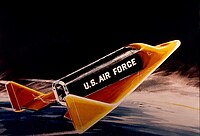The US has spent $1 billion on a weapon that has no mission. And started an arms race with China
The United States has spent $1 billion on a weapon that
has no mission. And started an arms race with China in the process.
...
Originally conceived by the U.S. Defense Department in 1957 as a manned intercontinental bomber, the "dynamic soaring" aircraft -- with its black cylindrical body and delta-shaped wings -- was designed to travel at more than five times the speed of sound. The plan was to use a large rocket to blast the Dyna-Soar into space. Then, rather than arcing high above the Earth, like a ballistic missile, it would re-enter the atmosphere quickly and glide to its target, without power, for vast distances; its creators envisioned a range of up to 12,000 miles.
The concept was simple, but its realization proved fiendishly difficult. In 1963, after spending more than $400 million (about $3 billion today), the Pentagon finally decided that the engineering challenges facing the Dyna-Soar were simply too expensive to overcome, and it canceled the project before the vehicle's first test.
But the interest in boost-glide weapons, as they're called, never completely faded. Some 40 years after the Dyna-Soar's demise, the United States reinvigorated its efforts to develop the technology.
By 2003, U.S. military planners had become worried that the country's long-range conventional weapons, such as cruise missiles, might be too slow to reach hypothetical distant targets that needed to be struck urgently. Although the United States has land- and sea-based ballistic missiles, which can travel much faster and can strike any conceivable enemy in 30 minutes or less, they are all nuclear-armed. So the Pentagon launched the Prompt Global Strike initiative to develop conventional weapons that could reach targets anywhere in the world within "minutes or hours." Boost-glide weapons -- re-envisioned as unmanned missiles that could destroy many types of targets simply by smacking into them at eye-watering speeds -- were an obvious candidate.
...
http://www.foreignpolicy.com/articles/2014/05/06/target_boost_glide_hypersonic_weapons_china_arms_race
unhappycamper
(60,364 posts)
Boeing X-20 Dyna-Soar
The Boeing X-20 Dyna-Soar ("Dynamic Soarer"
Other spacecraft under development at the time, such as Mercury or Vostok, were based on space capsules that returned on ballistic re-entry profiles. Dyna-Soar was more like the much later Space Shuttle. It could not only travel to distant targets at the speed of an intercontinental ballistic missile, it was designed to glide to earth like an aircraft under control of a pilot. It could land at an airfield, rather than simply falling to earth and landing with a parachute. Dyna-Soar could also reach earth orbit, like Mercury or Gemini.[2]
These characteristics made Dyna-Soar a far more advanced concept than other human spaceflight missions of the period. Research into a spaceplane was realized much later, in other reusable spacecraft such as the Space Shuttle,[3] which had its first orbital flight in 1981, and, more recently, the Boeing X-40 and X-37B spacecraft.